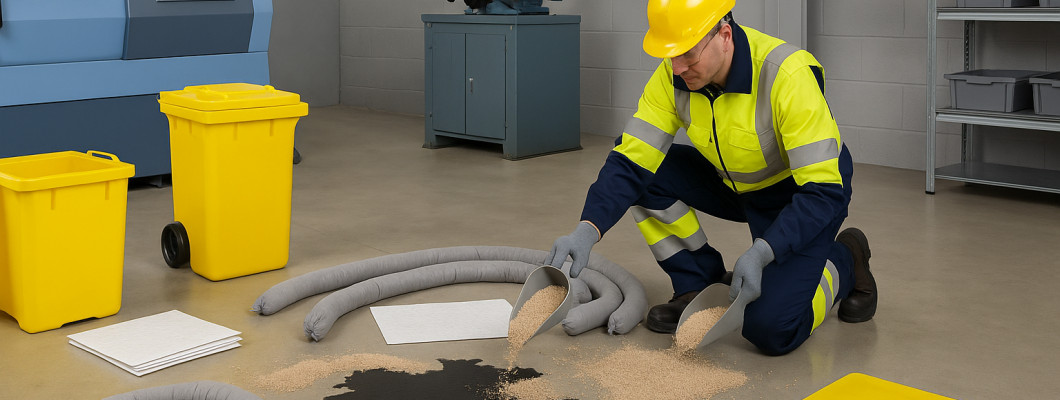
How to Choose the Right Spill Kit for Your Site
In any workplace, particularly those handling hazardous substances, having an effective spill kit is crucial for ensuring safety and compliance with UK regulations. Choosing the right spill kit can be a daunting task, but this guide will help you make an informed decision tailored to your site’s specific needs.
Understanding Spill Kits
Spill kits are essential for managing spills quickly and efficiently. They contain absorbent materials, protective gear, and disposal options tailored to various types of spills. Understanding the different types of spill kits available is the first step in making the right choice.
Types of Spill Kits
- General Purpose Spill Kits: Ideal for non-aggressive liquids like oil, water, and solvents.
- Oil Spill Kits: Designed specifically for oil spills, these kits repel water and are best suited for marine environments.
- Chemical Spill Kits: These kits are tailored for hazardous chemicals, featuring absorbents that neutralise or contain dangerous substances.
- Universal Spill Kits: A versatile option for handling a variety of spills, combining features of general purpose and chemical kits.
Assessing Your Site’s Needs
Before selecting a spill kit, assess your site’s specific requirements. Consider the following factors:
1. Types of Substances Handled
Identify the materials present in your facility. Are they hazardous? What is their viscosity? Understanding these factors will guide you towards the appropriate type of spill kit.
2. Size and Scale of Potential Spills
Evaluate the potential size of spills based on your operations. Larger operations may require kits with higher absorbent capacities or multiple kits placed strategically across the site.
3. Location and Accessibility
Choose locations for spill kits that are easily accessible in case of an emergency. Consider high-risk areas like loading docks, storage areas, and near machinery.
Regulatory Compliance
In the UK, compliance with health and safety regulations is vital. Familiarise yourself with the relevant legislation, such as:
- The Control of Substances Hazardous to Health (COSHH): Requires proper management of hazardous substances, including spill response.
- Environmental Protection Act: Mandates the containment of spills to prevent environmental damage.
- Health and Safety at Work Act: Ensures the safety of employees and places a duty on employers to manage risks.
Choosing the Right Size of Spill Kit
Spill kits come in various sizes, typically ranging from small, portable kits to larger, more comprehensive kits. When choosing the right size, consider:
- Small Kits: Suitable for minor spills or personal use, often containing absorbent pads, gloves, and bags.
- Medium Kits: Ideal for small to moderate spills, these kits contain a larger quantity of absorbents and personal protective equipment (PPE).
- Large Kits: Designed for significant spills, these kits include a vast array of absorbents, PPE, and disposal options.
Contents of a Spill Kit
Each spill kit should include essential items to effectively manage spills. Here’s a checklist of common contents:
- Absorbent Pads: Quick and efficient for soaking up spills.
- Absorbent Socks: Used to contain spills around machinery or in corners.
- Personal Protective Equipment: Gloves, goggles, and aprons to protect users during spill response.
- Disposal Bags: For safe disposal of contaminated materials.
- Instruction Manual: Clear guidelines on how to respond to spills safely.
Training and Maintenance
Having a spill kit is only part of the solution; proper training and maintenance are equally important. Here are some actionable steps:
1. Train Employees
Conduct regular training sessions to ensure all employees know how to use the spill kit effectively. Training should cover:
- Identification of different types of spills.
- Correct use of absorbents and PPE.
- Disposal procedures for contaminated materials.
2. Regular Inspections
Schedule routine inspections of spill kits to ensure all contents are present and in good condition. Check for:
- Expiry dates on absorbents and PPE.
- Completeness of the kit’s contents.
- Proper storage conditions to prevent degradation.
3. Update Training and Kits as Needed
As your operations change or new materials are introduced, update your spill kits and training to reflect these changes. Regularly review your spill management plan to ensure it remains compliant and effective.
Conclusion
Choosing the right spill kit for your site is a crucial step in ensuring safety and compliance with UK regulations. By understanding the types of spill kits, assessing your site’s needs, ensuring regulatory compliance, selecting the appropriate size, and maintaining your kits, you can effectively manage spills and protect your workforce and the environment. Invest time in training and regular maintenance to ensure your spill response is efficient and effective.
